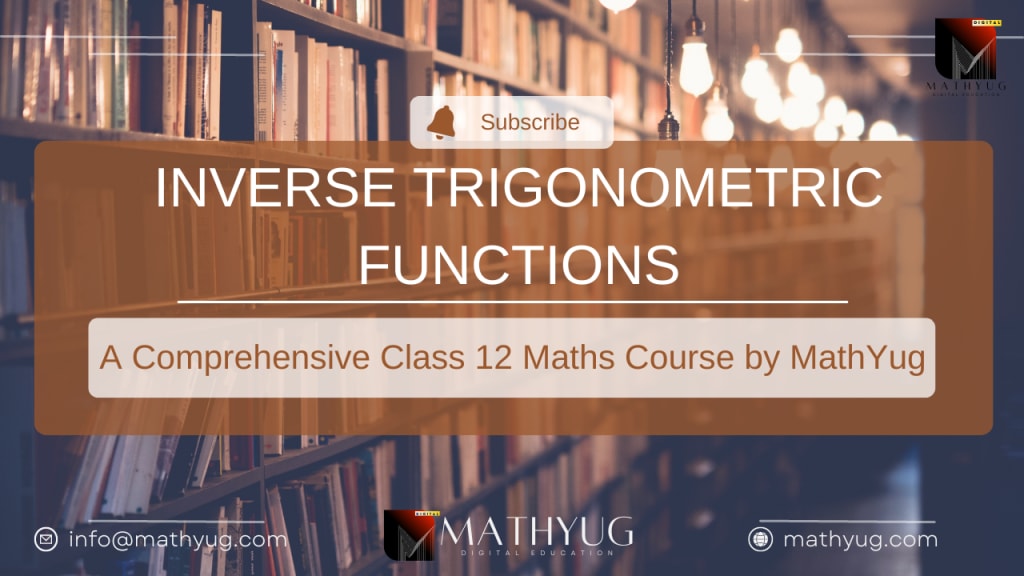An in-depth exploration of Inverse Trigonometric Functions for Class 12 Maths students
Crack the Code of Inverse Trigonometric Functions: A Complete Class 12 Maths Course by MathYug

Inverse trigonometric functions are essentially the inverse operations of the six fundamental trigonometric functions: sine, cosine, tangent, cotangent, secant, and cosecant. They are also referred to as arc functions since they return the angle whose sine, cosine, tangent, cotangent, secant, or cosecant equals a given value. Inverse trigonometric functions are a crucial topic in Class 12 Mathematics, and they are essential for solving trigonometry-related problems.
The six basic trigonometric functions are defined as ratios of the sides of a right triangle. For instance, the sine of an angle is the ratio of the length of the side opposite the angle to the length of the hypotenuse. Similarly, the cosine of an angle is the ratio of the length of the adjacent side to the length of the hypotenuse, and the tangent of an angle is the ratio of the length of the opposite side to the length of the adjacent side. The other three functions are defined as reciprocals of these functions.
The inverse trigonometric functions are defined in terms of the six fundamental trigonometric functions. For instance, the inverse sine function (also known as arcsine function) is defined as the angle whose sine is a given value. The inverse cosine function (also known as arccosine function) is defined as the angle whose cosine is a given value. The inverse tangent function (also known as arctangent function) is defined as the angle whose tangent is a given value. The other three functions are defined similarly.
The prefix "arc" is added to the function name to denote the inverse trigonometric functions. For example, the inverse sine function is denoted as arcsin(x), the inverse cosine function is denoted as arccos(x), and the inverse tangent function is denoted as arctan(x).
The inverse trigonometric functions' range is limited to guarantee that they have distinct values. For instance, the range of the inverse sine function is [-π/2, π/2], which means that the value of arcsin(x) is an angle between -π/2 and π/2 radians. Similarly, the range of the inverse cosine function is [0, π], and the range of the inverse tangent function is (-π/2, π/2).
The inverse trigonometric functions are useful in solving trigonometric equations and problems involving right triangles. For example, given the equation sin(x) = 1/2, we can use the inverse sine function to find the values of x. We know that sin(π/6) = 1/2, so we can write sin(x) = 1/2 as x = arcsin(1/2) + 2kπ or x = π – arcsin(1/2) + 2kπ, where k is an integer. This gives us the two solutions x = π/6 + 2kπ and x = 5π/6 + 2kπ.
MathYug is an excellent resource for students looking to master inverse trigonometric functions in Class 12 Maths. The platform offers high-quality video lectures, PDF notes, and assignments that are designed to be engaging, informative, and challenging. The MathYug team is dedicated to helping students achieve their academic goals and succeed in their exams.
Inverse Trigonometric Functions - Class 12 Maths (Part 1) | Mathyug
Inverse Trigonometric Functions can be challenging, but our Part 1 course provides a solid foundation for success.
Questions Discussed:
Simplify:
Question 1. tan^(-1)( sqrt(1-cosx)/(1+cosx) ), x < pi
Question 2. tan^(-1)( (cos x-sin x)/(cos x + sin x) ), x < pi
Question 3. cot^(-1)( 1/(sqrt(x^2)-1) ), |x| > 1
Question 4. tan^(-1)( 1/(sqrt(x^2)-1) ), |x| > 1
Question 5. tan^(-1)( (sqrt(1+x^2)-1)/x ), x ≠ 0
Question 6. tan^(-1)( x/sqrt(a^2-x^2) ), |x| < a
Part 1 of the Inverse Trigonometric Functions course is a comprehensive and engaging resource that covers a wide range of essential concepts and topics related to the subject. The course is delivered in Hindi and is designed specifically for English medium syllabus.
Throughout this course, you will explore a variety of key areas, including the derivation of identities and explanation of ranges for inverse trigonometric functions. These foundational concepts are crucial for developing a deep understanding of the subject and will provide a solid base for further exploration of more advanced topics.
To ensure that you gain a comprehensive understanding of the course material, Part 1 features carefully crafted practice questions that include evaluation, simplification, and solving problems. These questions are drawn from authoritative sources such as the NCERT Textbook, NCERT exemplar, Board's Question bank, and R.D. Sharma book (private publisher).
Join us for comprehensive explanations and practice problems drawn from sources like NCERT, Board's Question bank, and R.D. Sharma.
About the Creator
Prerna Kharbanda
Technology Enthusiast, Lifelong Learner, Explorer, and Co-Founder of MathYug
Enjoyed the story? Support the Creator.
Subscribe for free to receive all their stories in your feed. You could also pledge your support or give them a one-off tip, letting them know you appreciate their work.






Comments
There are no comments for this story
Be the first to respond and start the conversation.